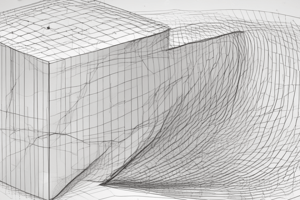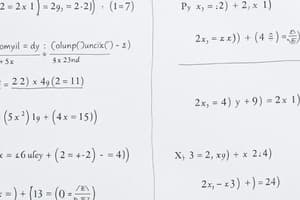Podcast
Questions and Answers
What transformation does the constant 'k' perform on the graph of the function $f(x) = x^3 - x^2 - 5x + k$?
What transformation does the constant 'k' perform on the graph of the function $f(x) = x^3 - x^2 - 5x + k$?
- Reflects the graph over the x-axis.
- Shifts the graph up or down. (correct)
- Stretches the graph horizontally.
- Compresses the graph vertically.
Given that $f(x) = x^3 - x^2 - 5x + k$, what is the correct derivative, $f'(x)$?
Given that $f(x) = x^3 - x^2 - 5x + k$, what is the correct derivative, $f'(x)$?
- $x^2 - 2x - 5$
- $3x^2 - x - 5$
- $x^3 - x^2 - 5x$
- $3x^2 - 2x - 5$ (correct)
Critical points of a function are only found where the derivative equals zero.
Critical points of a function are only found where the derivative equals zero.
False (B)
The derivative of a function is given by $f'(x) = 3x^2 - 2x - 5$. Which of the following values are the solutions to $f'(x) = 0$?
The derivative of a function is given by $f'(x) = 3x^2 - 2x - 5$. Which of the following values are the solutions to $f'(x) = 0$?
If the derivative of a function, $f'(x)$, changes from negative to positive at a critical point, what does this indicate about the function at that point?
If the derivative of a function, $f'(x)$, changes from negative to positive at a critical point, what does this indicate about the function at that point?
What is the purpose of using a sign chart when analyzing the derivative of a function?
What is the purpose of using a sign chart when analyzing the derivative of a function?
If $f'(x) > 0$ for $x < a$, $f'(x) < 0$ for $a < x < b$, and $f'(x) > 0$ for $x > b$, then 'a' represents a local minimum.
If $f'(x) > 0$ for $x < a$, $f'(x) < 0$ for $a < x < b$, and $f'(x) > 0$ for $x > b$, then 'a' represents a local minimum.
Given $f(x) = x^3 - x^2 - 5x + k$, to solve for $k$ if there's a relative maximum at $x = a$ with a value of $M$, we substitute $x = a$ into $f(x)$ and set it equal to ______.
Given $f(x) = x^3 - x^2 - 5x + k$, to solve for $k$ if there's a relative maximum at $x = a$ with a value of $M$, we substitute $x = a$ into $f(x)$ and set it equal to ______.
Given the function $f(x) = x^3 - x^2 - 5x + k$ has a relative maximum at $x = -1$, which calculation correctly uses this information to solve for $k$ if the relative maximum value is 6?
Given the function $f(x) = x^3 - x^2 - 5x + k$ has a relative maximum at $x = -1$, which calculation correctly uses this information to solve for $k$ if the relative maximum value is 6?
After substituting $x = -1$ into $f(x) = x^3 - x^2 - 5x + k$ and setting the result equal to 6, what simplified equation needs to be solved for $k$?
After substituting $x = -1$ into $f(x) = x^3 - x^2 - 5x + k$ and setting the result equal to 6, what simplified equation needs to be solved for $k$?
For the function $f(x) = x^3 - x^2 - 5x + k$, given that it has a relative maximum of 6 at $x = -1$, what is the value of $k$?
For the function $f(x) = x^3 - x^2 - 5x + k$, given that it has a relative maximum of 6 at $x = -1$, what is the value of $k$?
The value of 'k' that causes a vertical shift in a cubic function will affect the x-coordinates of the relative maxima and minima.
The value of 'k' that causes a vertical shift in a cubic function will affect the x-coordinates of the relative maxima and minima.
To find critical points, one must find where the first derivative of a function is either equal to zero or is ______.
To find critical points, one must find where the first derivative of a function is either equal to zero or is ______.
Match the function analysis step with its primary purpose:
Match the function analysis step with its primary purpose:
Explain the geometric significance of finding the value of x where $f'(x) = 0$ for a function $f(x)$.
Explain the geometric significance of finding the value of x where $f'(x) = 0$ for a function $f(x)$.
Which of the following statements accurately describes the use of the first derivative test?
Which of the following statements accurately describes the use of the first derivative test?
If a cubic function has only one real root for its derivative, it cannot have both a relative maximum and a relative minimum.
If a cubic function has only one real root for its derivative, it cannot have both a relative maximum and a relative minimum.
A point on a function where the derivative changes sign is referred to as a relative extremum. If $f'(x)$ changes from positive to negative at $x=c$, then $f(c)$ is a relative ______.
A point on a function where the derivative changes sign is referred to as a relative extremum. If $f'(x)$ changes from positive to negative at $x=c$, then $f(c)$ is a relative ______.
What condition is necessary for the quadratic equation resulting from taking the derivative of a cubic function, $f'(x) = 0$, to ensure that the original cubic function, $f(x)$, has two distinct relative extrema?
What condition is necessary for the quadratic equation resulting from taking the derivative of a cubic function, $f'(x) = 0$, to ensure that the original cubic function, $f(x)$, has two distinct relative extrema?
Suppose a function has a relative maximum where $x = a$. Explain why simply knowing $f(a)$ isn't enough to fully define the original function $f(x) = x^3 - x^2 - 5x + k$ in this context.
Suppose a function has a relative maximum where $x = a$. Explain why simply knowing $f(a)$ isn't enough to fully define the original function $f(x) = x^3 - x^2 - 5x + k$ in this context.
Flashcards
What does 'k' do in a function?
What does 'k' do in a function?
A constant that shifts the graph of a function up or down on the y-axis.
How to solve for 'k'?
How to solve for 'k'?
To find 'k', determine the x-value of the relative maximum, plug it into the original function, set equal to the given y-value, and solve for 'k'.
What is the derivative of f(x) = x³ - x² - 5x + k?
What is the derivative of f(x) = x³ - x² - 5x + k?
f'(x) = 3x² - 2x - 5
What are critical points?
What are critical points?
Signup and view all the flashcards
How do you find critical points?
How do you find critical points?
Signup and view all the flashcards
Factored form of 3x² - 2x - 5 = 0?
Factored form of 3x² - 2x - 5 = 0?
Signup and view all the flashcards
What are the solutions to (3x - 5)(x + 1) = 0?
What are the solutions to (3x - 5)(x + 1) = 0?
Signup and view all the flashcards
What is a sign chart?
What is a sign chart?
Signup and view all the flashcards
What intervals are created by the critical points x = -1 and x = 5/3?
What intervals are created by the critical points x = -1 and x = 5/3?
Signup and view all the flashcards
How does the sign of f'(x) change at a relative maximum?
How does the sign of f'(x) change at a relative maximum?
Signup and view all the flashcards
Where does the relative maximum occur?
Where does the relative maximum occur?
Signup and view all the flashcards
What is the value of k?
What is the value of k?
Signup and view all the flashcards
Study Notes
Solving for k in a Cubic Function with a Given Relative Maximum
- The problem is to find the value of k for the function f(x) = x³ - x² - 5x + k such that it has a relative maximum of 6.
- The constant k shifts the graph of the function up or down.
- The aim is to determine the value of k that shifts the graph so the relative maximum has a y-value of 6.
Finding the Derivative and Critical Points
- The derivative of f(x) is f'(x) = 3x² - 2x - 5.
- Critical points occur where the derivative is zero or undefined.
- In this case, the derivative is defined for all real numbers, so we only need to find where it equals zero.
- Setting the derivative equal to zero: 3x² - 2x - 5 = 0.
Factoring the Quadratic Equation
- The quadratic equation can be factored as (3x - 5)(x + 1) = 0.
- Solving for x gives two critical points: x = 5/3 and x = -1.
Using a Sign Chart to Determine Relative Maxima
- A sign chart is used to determine whether each critical point is a relative maximum or minimum.
- The number line is divided into intervals based on the critical points: x < -1, -1 < x < 5/3, and x > 5/3.
- By testing values in each interval, determine the sign of the derivative in that interval:
- For x < -1, f'(x) is positive (increasing).
- For -1 < x < 5/3, f'(x) is negative (decreasing).
- For x > 5/3, f'(x) is positive (increasing).
- The derivative changes from positive to negative at x = -1, indicating a relative maximum.
Solving for k Using the Relative Maximum
- The relative maximum occurs at x = -1, and we know the value of the function at this point is 6.
- Plug x = -1 into the original function: f(-1) = (-1)³ - (-1)² - 5(-1) + k = 6.
- Simplify the equation: -1 - 1 + 5 + k = 6.
- Combine terms: 3 + k = 6.
- Solve for k: k = 6 - 3 = 3.
Studying That Suits You
Use AI to generate personalized quizzes and flashcards to suit your learning preferences.




